Attractions · Europe · Food and Drink · Going Out · Regions · Restaurants · Spain · Travel Miscellany · Western Europe
Spain’s Stonehenge – the heart and soul of Andalusia in ancient Antequera
Little known outside of Andalusia until recently, the ancient city of Antequera in Malaga province has gained a lot of international recognition of late. Much of this renewed attention comes thanks to the Antequera Dolmens Site being awarded a UNESCO World Heritage designation in July of 2016; however, the town has held strategic importance for millennia. So old is the settlement, dating back at least as far as the Bronze age, that the Romans already named the site Antequaria, the ancient city, before the time of Christ.
Today Antequera is known as the heart of Andalusia for its central location midway between Malaga to the south and Cordoba to the north, Sevilla to the west and Granada to the east. Its illustrious and extensive history makes it a fascinating stop, and its central location makes it easily accessible for day trips from the more popular and populous Andalusian destinations. This, along with its new UNESCO designation, likely explains why the New York Times identified Antequera as one of its 52 Places to Go in 2017, an annual list of international must-see destinations.
 But how to make the most of this impressive destination? Here are a few tips
1. Tour the UNESCO sites including the Dolmens of Antequera and the bizarre landscapes of El Torcal natural monument
The New York Times refers to Antequera as the Spanish Stonehenge for the three dolmens located in the city. These 5,000 year old megalithic burial sites are the largest such structures in Europe, and unique in that virtually all other similar dolmens in Europe face the sunrise at equinox, while these face natural mountainscapes, including those of El Torcal. The largest of the stones used to construct the largest of the three dolmens is estimated to weigh 180 tonnes and the chambre reaches a height of four metres.
But how to make the most of this impressive destination? Here are a few tips
1. Tour the UNESCO sites including the Dolmens of Antequera and the bizarre landscapes of El Torcal natural monument
The New York Times refers to Antequera as the Spanish Stonehenge for the three dolmens located in the city. These 5,000 year old megalithic burial sites are the largest such structures in Europe, and unique in that virtually all other similar dolmens in Europe face the sunrise at equinox, while these face natural mountainscapes, including those of El Torcal. The largest of the stones used to construct the largest of the three dolmens is estimated to weigh 180 tonnes and the chambre reaches a height of four metres.
 The El Torcal mountain nature park is included in Antequeras UNESCO designation thanks to its connection to the dolmens as a focal point from one of the entrances and the uniqueness of the limestone structures, which form one of the most important karst landscapes in Europe. A hike through the park reveals a bizarre grouping of enormous rock formations appearing like giant stacks of flat stone. The distinctive formations result from eons of erosion, including from the fact that 150m years ago the mountain lay in a marine corridor underwater, but was later pushed to a height of more than 1300 metres.
The El Torcal mountain nature park is included in Antequeras UNESCO designation thanks to its connection to the dolmens as a focal point from one of the entrances and the uniqueness of the limestone structures, which form one of the most important karst landscapes in Europe. A hike through the park reveals a bizarre grouping of enormous rock formations appearing like giant stacks of flat stone. The distinctive formations result from eons of erosion, including from the fact that 150m years ago the mountain lay in a marine corridor underwater, but was later pushed to a height of more than 1300 metres.
 2. Explore the architecture of Antequera from across the ages
With its strategic position in the heart of Andalusia, Antequera changed hands numerous times to various conquerors over the millennia. The result is a rich legacy of varied architecture spanning at least 2,000 years. The Moorish castle on the citys highpoint is remarkably well preserved with remnants of its original Moorish masters as well as the Catholic kings following the reconquest. The dense city centre is a labyrinth of baroque and renaissance buildings with some exemplary cathedrals. Much of the centre is like an open air museum, prime for wandering and exploring; however, to really understand the mesh of styles and influences an expert guide is recommended (see final note below).
2. Explore the architecture of Antequera from across the ages
With its strategic position in the heart of Andalusia, Antequera changed hands numerous times to various conquerors over the millennia. The result is a rich legacy of varied architecture spanning at least 2,000 years. The Moorish castle on the citys highpoint is remarkably well preserved with remnants of its original Moorish masters as well as the Catholic kings following the reconquest. The dense city centre is a labyrinth of baroque and renaissance buildings with some exemplary cathedrals. Much of the centre is like an open air museum, prime for wandering and exploring; however, to really understand the mesh of styles and influences an expert guide is recommended (see final note below).
 3. Eat like the locals have for centuries
There are more than a few fine dining establishments in Antequera, though you wont find anything too fancy or pretentious here tradition trumps modernity. One particular restaurant of note is Arte de Cozina, where head chef Charo Carmona has made a name for herself across all of Andalusia with a focus on reviving, or at least sustaining, recipes from antiquity. Antequera is famous for a type of cold soup called porra, today served almost exclusively with a tomato based emulsion thickened with bread crumbs and olive oil, and garnishes such as boiled egg, croutons, diced peppers and seasoned oil. Chef Carmona revives the ancient recipe from before the introduction of tomatoes to Europe from the New World, using instead orange juice to flavor the dish, or the simplest form using only garlic, breadcrumbs, olive oil, vinegar and salt. Various sorts of stews also lost to time grace the menu, as do some very rustic faire such as veal tongue and snails in almond sauce. Every meal is an adventure.
Caserio de San Benito sits just outside of the city, but has an equally impressive menu full of traditional, if not as ancient, Andalusian dishes. The building itself exudes an old world charm, capturing the typical Andalusian constructs of the 18th century, and dining here is like stepping back in time. If it feels a bit like a museum thats no mistake; an adjacent chapel displays all sorts of antique memorabilia and curiosities.
3. Eat like the locals have for centuries
There are more than a few fine dining establishments in Antequera, though you wont find anything too fancy or pretentious here tradition trumps modernity. One particular restaurant of note is Arte de Cozina, where head chef Charo Carmona has made a name for herself across all of Andalusia with a focus on reviving, or at least sustaining, recipes from antiquity. Antequera is famous for a type of cold soup called porra, today served almost exclusively with a tomato based emulsion thickened with bread crumbs and olive oil, and garnishes such as boiled egg, croutons, diced peppers and seasoned oil. Chef Carmona revives the ancient recipe from before the introduction of tomatoes to Europe from the New World, using instead orange juice to flavor the dish, or the simplest form using only garlic, breadcrumbs, olive oil, vinegar and salt. Various sorts of stews also lost to time grace the menu, as do some very rustic faire such as veal tongue and snails in almond sauce. Every meal is an adventure.
Caserio de San Benito sits just outside of the city, but has an equally impressive menu full of traditional, if not as ancient, Andalusian dishes. The building itself exudes an old world charm, capturing the typical Andalusian constructs of the 18th century, and dining here is like stepping back in time. If it feels a bit like a museum thats no mistake; an adjacent chapel displays all sorts of antique memorabilia and curiosities.
 4. Shop for antiques in the antique city
With such an ancient history, it comes as no surprise that Antequera would have some of the best antique shopping available in all of Andalusia. Even a short wander through the old centre will reveal a number of interesting and authentic antique shops, while just outside of the city sit a pair of huge and fascinating shops filled to the ceilings with endless antiguedades that will make any collectors mouth water. Sitting almost side by side, Las Tinajas and Antiguedades Juan Dorado sell everything from wooden furniture and massive entrance doors, to clay pots and urns, sculptures and art, knick-knacks and early electronics. Prices are not marked so be prepared to haggle, and never fear, they can gladly ship any larger items to you wherever you call home.
5. Tour a local olive mill
The inland city of Antequera sits at the edge of the interior plains, where for miles and miles all the horizon reveals is a vast canvass of endless olive groves. Some of the best olive oil in the world is made here with a tradition stretching back to the era of the Phoenicians who first brought olive trees to the region 3,000 years ago. The prevalent variety here is called Hojiblanca, with a rich, grassy flavour. A few of the local farms and mills offer regular tours of the grounds and facilities, with instructive guides and tastings to note the differences in colour, flavour and process.
The Finca la Torre (https://aceitefincalatorre.com/en/) brand olive oil produced nearby has consistently ranked as one of the top ten olive oils in the world for at least the past few years. Some rankings placed their Hojiblanca olive oil best in the world in 2015. Contact the mill directly for a guided tour.
4. Shop for antiques in the antique city
With such an ancient history, it comes as no surprise that Antequera would have some of the best antique shopping available in all of Andalusia. Even a short wander through the old centre will reveal a number of interesting and authentic antique shops, while just outside of the city sit a pair of huge and fascinating shops filled to the ceilings with endless antiguedades that will make any collectors mouth water. Sitting almost side by side, Las Tinajas and Antiguedades Juan Dorado sell everything from wooden furniture and massive entrance doors, to clay pots and urns, sculptures and art, knick-knacks and early electronics. Prices are not marked so be prepared to haggle, and never fear, they can gladly ship any larger items to you wherever you call home.
5. Tour a local olive mill
The inland city of Antequera sits at the edge of the interior plains, where for miles and miles all the horizon reveals is a vast canvass of endless olive groves. Some of the best olive oil in the world is made here with a tradition stretching back to the era of the Phoenicians who first brought olive trees to the region 3,000 years ago. The prevalent variety here is called Hojiblanca, with a rich, grassy flavour. A few of the local farms and mills offer regular tours of the grounds and facilities, with instructive guides and tastings to note the differences in colour, flavour and process.
The Finca la Torre (https://aceitefincalatorre.com/en/) brand olive oil produced nearby has consistently ranked as one of the top ten olive oils in the world for at least the past few years. Some rankings placed their Hojiblanca olive oil best in the world in 2015. Contact the mill directly for a guided tour.
 In nearby Riogordo, the Museo Etnografico offers a look back at olive oil production in the area from the early 20th century. The hacienda is open to the public for tours and often includes relevant temporary art exhibits. The olive mill itself displays the antique mechanisms used from Roman times up until the industrial revolution, when cone shaped mill stones were rotated by donkeys walking in a circle around the mill. Later devices are also on display for a glimpse at the development of the milling processes across the centuries.
Its worth noting here that you could combine a number of these experiences with an expertly guided tour from the boutique, culinary travel planners at Paladar y Tomar. Their Olive Oil Experience & Antequera day trip includes a tour of the dolmens and a prestigious local olive mill, as well as an exploration of the citys Baroque and Renaissance architecture, plus highlights of the local cuisine.
Alan Hazel is Owner and Director of Cortijo El Carligto.
If you would like to be a guest blogger on A Luxury Travel Blog in order to raise your profile, please contact us.
In nearby Riogordo, the Museo Etnografico offers a look back at olive oil production in the area from the early 20th century. The hacienda is open to the public for tours and often includes relevant temporary art exhibits. The olive mill itself displays the antique mechanisms used from Roman times up until the industrial revolution, when cone shaped mill stones were rotated by donkeys walking in a circle around the mill. Later devices are also on display for a glimpse at the development of the milling processes across the centuries.
Its worth noting here that you could combine a number of these experiences with an expertly guided tour from the boutique, culinary travel planners at Paladar y Tomar. Their Olive Oil Experience & Antequera day trip includes a tour of the dolmens and a prestigious local olive mill, as well as an exploration of the citys Baroque and Renaissance architecture, plus highlights of the local cuisine.
Alan Hazel is Owner and Director of Cortijo El Carligto.
If you would like to be a guest blogger on A Luxury Travel Blog in order to raise your profile, please contact us.
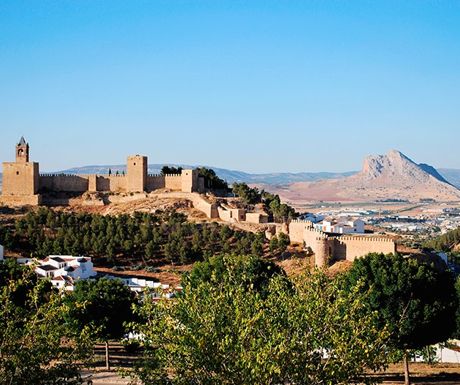 But how to make the most of this impressive destination? Here are a few tips
1. Tour the UNESCO sites including the Dolmens of Antequera and the bizarre landscapes of El Torcal natural monument
The New York Times refers to Antequera as the Spanish Stonehenge for the three dolmens located in the city. These 5,000 year old megalithic burial sites are the largest such structures in Europe, and unique in that virtually all other similar dolmens in Europe face the sunrise at equinox, while these face natural mountainscapes, including those of El Torcal. The largest of the stones used to construct the largest of the three dolmens is estimated to weigh 180 tonnes and the chambre reaches a height of four metres.
But how to make the most of this impressive destination? Here are a few tips
1. Tour the UNESCO sites including the Dolmens of Antequera and the bizarre landscapes of El Torcal natural monument
The New York Times refers to Antequera as the Spanish Stonehenge for the three dolmens located in the city. These 5,000 year old megalithic burial sites are the largest such structures in Europe, and unique in that virtually all other similar dolmens in Europe face the sunrise at equinox, while these face natural mountainscapes, including those of El Torcal. The largest of the stones used to construct the largest of the three dolmens is estimated to weigh 180 tonnes and the chambre reaches a height of four metres.
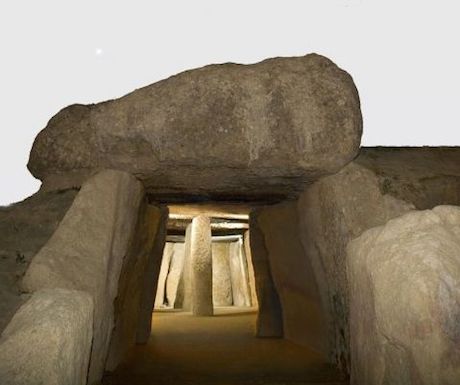 The El Torcal mountain nature park is included in Antequeras UNESCO designation thanks to its connection to the dolmens as a focal point from one of the entrances and the uniqueness of the limestone structures, which form one of the most important karst landscapes in Europe. A hike through the park reveals a bizarre grouping of enormous rock formations appearing like giant stacks of flat stone. The distinctive formations result from eons of erosion, including from the fact that 150m years ago the mountain lay in a marine corridor underwater, but was later pushed to a height of more than 1300 metres.
The El Torcal mountain nature park is included in Antequeras UNESCO designation thanks to its connection to the dolmens as a focal point from one of the entrances and the uniqueness of the limestone structures, which form one of the most important karst landscapes in Europe. A hike through the park reveals a bizarre grouping of enormous rock formations appearing like giant stacks of flat stone. The distinctive formations result from eons of erosion, including from the fact that 150m years ago the mountain lay in a marine corridor underwater, but was later pushed to a height of more than 1300 metres.
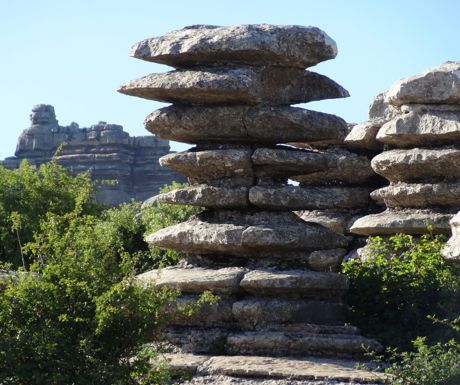 2. Explore the architecture of Antequera from across the ages
With its strategic position in the heart of Andalusia, Antequera changed hands numerous times to various conquerors over the millennia. The result is a rich legacy of varied architecture spanning at least 2,000 years. The Moorish castle on the citys highpoint is remarkably well preserved with remnants of its original Moorish masters as well as the Catholic kings following the reconquest. The dense city centre is a labyrinth of baroque and renaissance buildings with some exemplary cathedrals. Much of the centre is like an open air museum, prime for wandering and exploring; however, to really understand the mesh of styles and influences an expert guide is recommended (see final note below).
2. Explore the architecture of Antequera from across the ages
With its strategic position in the heart of Andalusia, Antequera changed hands numerous times to various conquerors over the millennia. The result is a rich legacy of varied architecture spanning at least 2,000 years. The Moorish castle on the citys highpoint is remarkably well preserved with remnants of its original Moorish masters as well as the Catholic kings following the reconquest. The dense city centre is a labyrinth of baroque and renaissance buildings with some exemplary cathedrals. Much of the centre is like an open air museum, prime for wandering and exploring; however, to really understand the mesh of styles and influences an expert guide is recommended (see final note below).
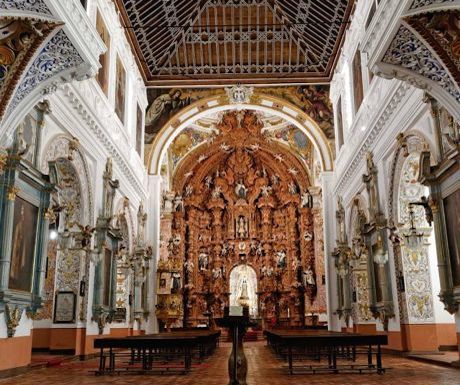 3. Eat like the locals have for centuries
There are more than a few fine dining establishments in Antequera, though you wont find anything too fancy or pretentious here tradition trumps modernity. One particular restaurant of note is Arte de Cozina, where head chef Charo Carmona has made a name for herself across all of Andalusia with a focus on reviving, or at least sustaining, recipes from antiquity. Antequera is famous for a type of cold soup called porra, today served almost exclusively with a tomato based emulsion thickened with bread crumbs and olive oil, and garnishes such as boiled egg, croutons, diced peppers and seasoned oil. Chef Carmona revives the ancient recipe from before the introduction of tomatoes to Europe from the New World, using instead orange juice to flavor the dish, or the simplest form using only garlic, breadcrumbs, olive oil, vinegar and salt. Various sorts of stews also lost to time grace the menu, as do some very rustic faire such as veal tongue and snails in almond sauce. Every meal is an adventure.
Caserio de San Benito sits just outside of the city, but has an equally impressive menu full of traditional, if not as ancient, Andalusian dishes. The building itself exudes an old world charm, capturing the typical Andalusian constructs of the 18th century, and dining here is like stepping back in time. If it feels a bit like a museum thats no mistake; an adjacent chapel displays all sorts of antique memorabilia and curiosities.
3. Eat like the locals have for centuries
There are more than a few fine dining establishments in Antequera, though you wont find anything too fancy or pretentious here tradition trumps modernity. One particular restaurant of note is Arte de Cozina, where head chef Charo Carmona has made a name for herself across all of Andalusia with a focus on reviving, or at least sustaining, recipes from antiquity. Antequera is famous for a type of cold soup called porra, today served almost exclusively with a tomato based emulsion thickened with bread crumbs and olive oil, and garnishes such as boiled egg, croutons, diced peppers and seasoned oil. Chef Carmona revives the ancient recipe from before the introduction of tomatoes to Europe from the New World, using instead orange juice to flavor the dish, or the simplest form using only garlic, breadcrumbs, olive oil, vinegar and salt. Various sorts of stews also lost to time grace the menu, as do some very rustic faire such as veal tongue and snails in almond sauce. Every meal is an adventure.
Caserio de San Benito sits just outside of the city, but has an equally impressive menu full of traditional, if not as ancient, Andalusian dishes. The building itself exudes an old world charm, capturing the typical Andalusian constructs of the 18th century, and dining here is like stepping back in time. If it feels a bit like a museum thats no mistake; an adjacent chapel displays all sorts of antique memorabilia and curiosities.
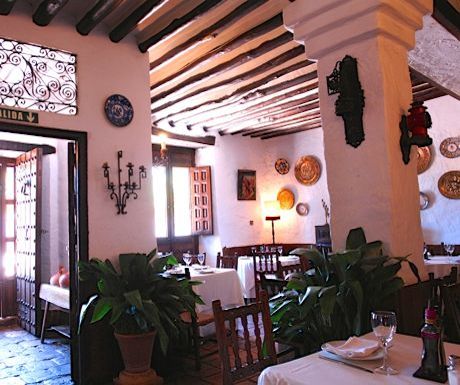 4. Shop for antiques in the antique city
With such an ancient history, it comes as no surprise that Antequera would have some of the best antique shopping available in all of Andalusia. Even a short wander through the old centre will reveal a number of interesting and authentic antique shops, while just outside of the city sit a pair of huge and fascinating shops filled to the ceilings with endless antiguedades that will make any collectors mouth water. Sitting almost side by side, Las Tinajas and Antiguedades Juan Dorado sell everything from wooden furniture and massive entrance doors, to clay pots and urns, sculptures and art, knick-knacks and early electronics. Prices are not marked so be prepared to haggle, and never fear, they can gladly ship any larger items to you wherever you call home.
5. Tour a local olive mill
The inland city of Antequera sits at the edge of the interior plains, where for miles and miles all the horizon reveals is a vast canvass of endless olive groves. Some of the best olive oil in the world is made here with a tradition stretching back to the era of the Phoenicians who first brought olive trees to the region 3,000 years ago. The prevalent variety here is called Hojiblanca, with a rich, grassy flavour. A few of the local farms and mills offer regular tours of the grounds and facilities, with instructive guides and tastings to note the differences in colour, flavour and process.
The Finca la Torre (https://aceitefincalatorre.com/en/) brand olive oil produced nearby has consistently ranked as one of the top ten olive oils in the world for at least the past few years. Some rankings placed their Hojiblanca olive oil best in the world in 2015. Contact the mill directly for a guided tour.
4. Shop for antiques in the antique city
With such an ancient history, it comes as no surprise that Antequera would have some of the best antique shopping available in all of Andalusia. Even a short wander through the old centre will reveal a number of interesting and authentic antique shops, while just outside of the city sit a pair of huge and fascinating shops filled to the ceilings with endless antiguedades that will make any collectors mouth water. Sitting almost side by side, Las Tinajas and Antiguedades Juan Dorado sell everything from wooden furniture and massive entrance doors, to clay pots and urns, sculptures and art, knick-knacks and early electronics. Prices are not marked so be prepared to haggle, and never fear, they can gladly ship any larger items to you wherever you call home.
5. Tour a local olive mill
The inland city of Antequera sits at the edge of the interior plains, where for miles and miles all the horizon reveals is a vast canvass of endless olive groves. Some of the best olive oil in the world is made here with a tradition stretching back to the era of the Phoenicians who first brought olive trees to the region 3,000 years ago. The prevalent variety here is called Hojiblanca, with a rich, grassy flavour. A few of the local farms and mills offer regular tours of the grounds and facilities, with instructive guides and tastings to note the differences in colour, flavour and process.
The Finca la Torre (https://aceitefincalatorre.com/en/) brand olive oil produced nearby has consistently ranked as one of the top ten olive oils in the world for at least the past few years. Some rankings placed their Hojiblanca olive oil best in the world in 2015. Contact the mill directly for a guided tour.
 In nearby Riogordo, the Museo Etnografico offers a look back at olive oil production in the area from the early 20th century. The hacienda is open to the public for tours and often includes relevant temporary art exhibits. The olive mill itself displays the antique mechanisms used from Roman times up until the industrial revolution, when cone shaped mill stones were rotated by donkeys walking in a circle around the mill. Later devices are also on display for a glimpse at the development of the milling processes across the centuries.
Its worth noting here that you could combine a number of these experiences with an expertly guided tour from the boutique, culinary travel planners at Paladar y Tomar. Their Olive Oil Experience & Antequera day trip includes a tour of the dolmens and a prestigious local olive mill, as well as an exploration of the citys Baroque and Renaissance architecture, plus highlights of the local cuisine.
Alan Hazel is Owner and Director of Cortijo El Carligto.
If you would like to be a guest blogger on A Luxury Travel Blog in order to raise your profile, please contact us.
In nearby Riogordo, the Museo Etnografico offers a look back at olive oil production in the area from the early 20th century. The hacienda is open to the public for tours and often includes relevant temporary art exhibits. The olive mill itself displays the antique mechanisms used from Roman times up until the industrial revolution, when cone shaped mill stones were rotated by donkeys walking in a circle around the mill. Later devices are also on display for a glimpse at the development of the milling processes across the centuries.
Its worth noting here that you could combine a number of these experiences with an expertly guided tour from the boutique, culinary travel planners at Paladar y Tomar. Their Olive Oil Experience & Antequera day trip includes a tour of the dolmens and a prestigious local olive mill, as well as an exploration of the citys Baroque and Renaissance architecture, plus highlights of the local cuisine.
Alan Hazel is Owner and Director of Cortijo El Carligto.
If you would like to be a guest blogger on A Luxury Travel Blog in order to raise your profile, please contact us.Did you enjoy this article?
Receive similar content direct to your inbox.


Wow Alan, talk about synergy :) I was just reading about megalithic sites in Spain yesterday. Super article. I haven’t been to Antequera for a while, but did go to the Wolf Park also when there.
Thanks for your comments Jackie. A visit to these dolmens truly is fascinating if you have an interest in this kind of historic site; well worth a visit, especially as part of a wider exploration of Antequera!
Thank you for these fascinating tips. So much to explore from popular destinations. Will make mental note to visit.
Jackie, maybe you were following a virtual ley line! Kidding aside you should see the dolmens at Antequera – they feel like they were built very recently as they are so well constructed.